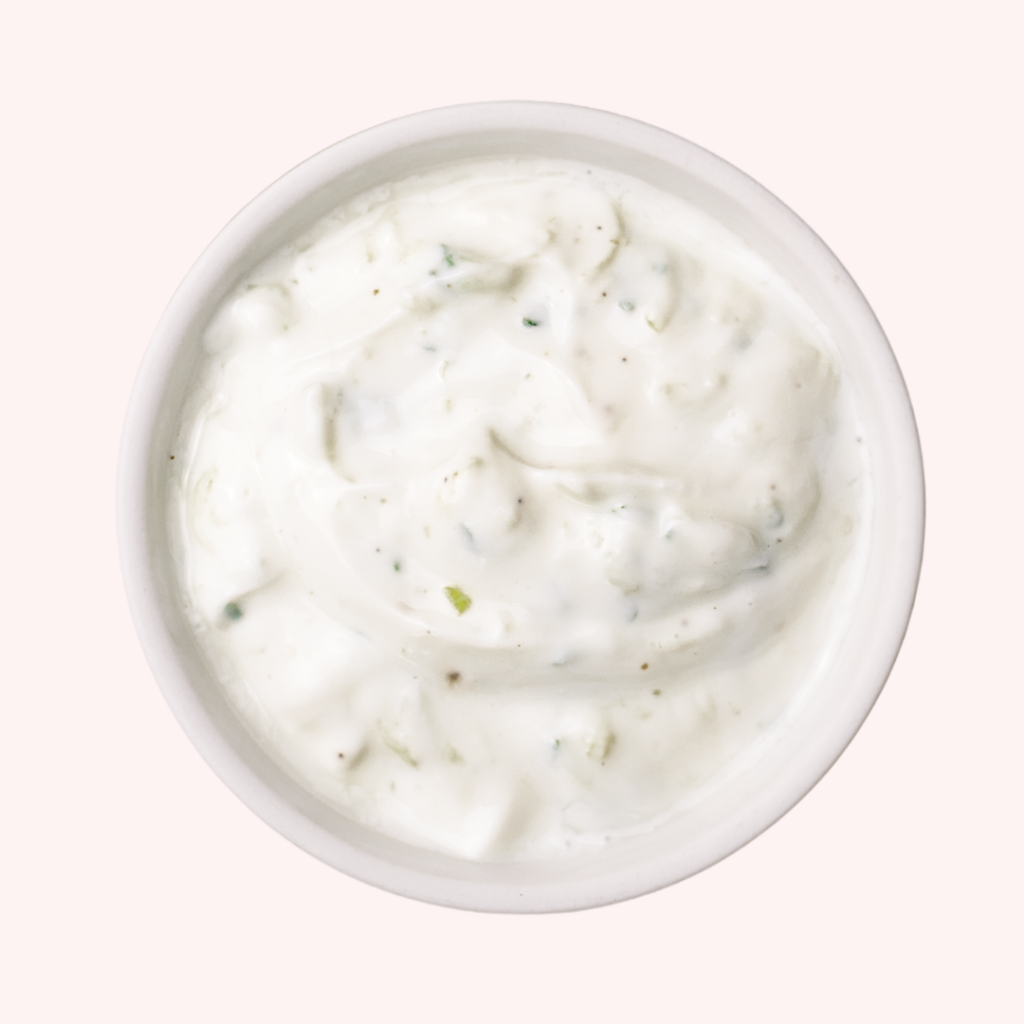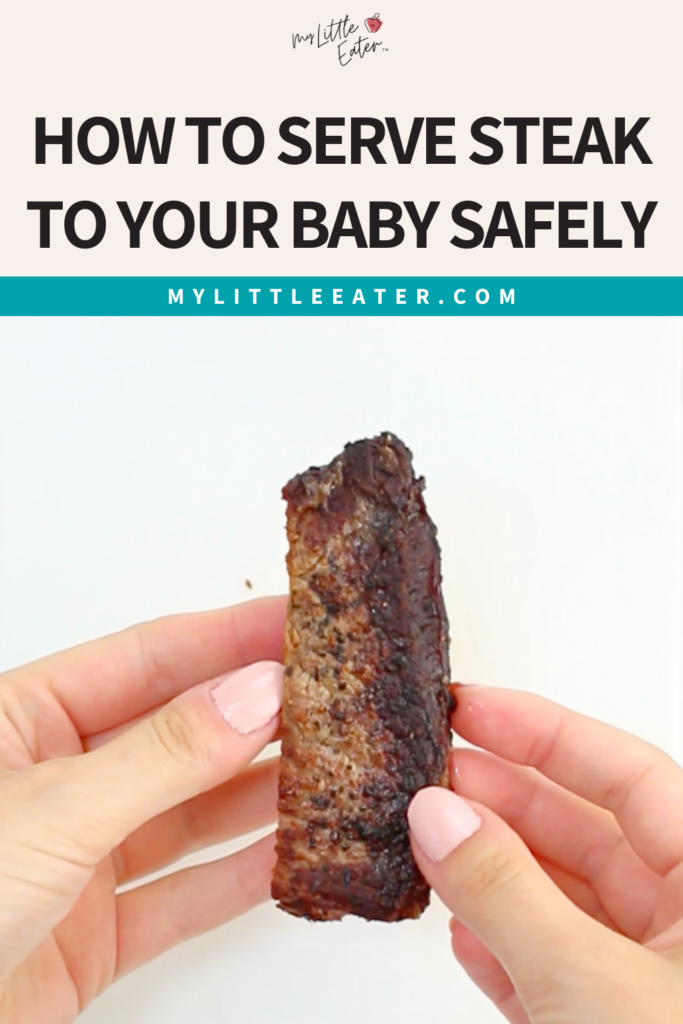Steak is one of the scariest foods to think about offering to your baby. After all, adults sometimes choke on it so how can a baby eat it?
Well, shockingly enough, they can!
There are safety considerations to keep in mind, as with all foods, so we’ll go over how you can safely serve it, plus cooking safety, tips on the best type of steak for babies, and the nutrition info you need to know.

If you’re feeling overwhelmed about starting solids and you’re not sure where to begin, join our FREE workshop – How to start solids: A realistic first week of feeding your baby. This workshop is for parents ready to feel confident and prepared to start solids—without all the guesswork.
Learn exactly what to feed, when to feed it, and how to do it—step-by-step—with expert guidance from pediatric dietitian, Edwena Kennedy. Plus, get a FREE 5 day meal plan just for attending!

If you’re just getting started with solids, or you’ve started but aren’t sure what to do or serve next, check out our Baby Led Feeding online course!
With all of the info you need to start solids safely, including access to our full Texture Timeline™ Food Video Library, you’ll know how to safely serve all foods, and what you should be working on next with your baby.
Table of Contents
When can babies eat steak?
Steak can be served as soon as your baby is ready to start solids. This is typically around 6 months of age, but we recommend waiting until your baby is showing all of the developmental signs of readiness before offering that first solid food.
Watch baby Charley go!
Watch baby Charley go!
Baby Charley is about 7 months old in this video. She’s enjoying steak as a phase 0 food – a hard, resistive whole food – because she doesn’t have any teeth and cannot tear through the steak, which makes it safe to serve this way. More on that below!
Is steak a choking hazard for babies?
Steak is a common choking hazard for babies, and even adults, like most other types of meat.
To reduce the risk of choking, always make sure meat is moist by adding yogurt, pasta sauce, pesto, or another sauce before offering it to your baby. You can also mix shredded meat in with other moist foods like hummus, mashed potatoes, etc.

Do not serve your baby cube-shaped pieces of steak because these are the perfect size and shape to block their airway.
Always make sure you’re offering your baby appropriate foods based on their skill level and ability to chew their food thoroughly.
Buying the best kind of steak for baby led weaning
There are a lot of different types of steak on the market, ranging from the less expensive, like an eye of round steak, to the more expensive options like tenderloin cuts.

As you’ll see below, steak falls on two different sections of our Texture Timeline™ – phase 0 and phase 3.
What is the Texture Timeline™?
A tool exclusive to My Little Eater that allows you to start solids with your baby using purées, finger foods, or a mixture of both. We sort all foods into different phases of the timeline based on texture difficulty, presenting multiple ways to serve each food depending on what you and your baby are ready for.
You can start with any phase of the Texture Timeline™. The goal is to always be moving forward on the timeline so that you can advance your baby to more challenging textures in a timely manner. This will allow your baby to develop and practice new eating skills and ensure that they don’t stay stuck on one texture for too long.
Using the Texture Timeline™ can help to prevent picky eating, all while keeping the feeding process enjoyable and less stressful for you because you can ease into the difficult textures that often cause more anxiety and worry.
For phase 0 (hard, resistive foods or very thin purees), it doesn’t matter what type of steak you choose. This is because your baby will mostly be sucking on it and gnawing on it with their gums, but won’t actually be taking bites or chewing any of it.
Therefore, it’s nice to have a piece of steak that is still moist so they can suck on it and get some of the nutrients from it through the juices, but you don’t have to stress as much about buying a particular cut for tenderness.
For phase 3 (expanded level including various textures), you’ll be shredding the cooked steak to serve on its own or mixed into a binder. You’ll need to purchase a type of steak that can easily be made tender and kept moist enough to shred once cooked.
The cooking process affects this as well, but if you start with a good cut of meat to begin with, there isn’t as much pressure on you to get the cooking process absolutely perfect.
That doesn’t mean you have to splurge on the best steak your grocery store has to offer! Instead, keep these tips in mind…
- Check for freshness – don’t buy a steak that is close to or after the best-before date.
- Check that the packaging is intact – this is more of a safety concern, but important nonetheless!
- Watch for marbling – the more marbling (ie. white fat throughout the steak) the more tender it will be. This doesn’t mean you want a steak with a large piece of fat, but instead, you’re looking for thin lines of fat running in all directions throughout the entire cut of meat.
- Shop within your means – if you can afford a certain type of steak and the others are over your budget, don’t stress! There are other ways that you can help keep the meat tender and moist for your little one, let’s go over those next!

Preparing steak for babies
When it comes to meat, the most important thing is keeping it moist and tender for your baby. One of the best ways to do this is by marinating the meat before cooking.
Marinating your steak before cooking it, especially in something like yogurt that helps to tenderize the steak as well, can make it easier to keep tender and moist during the cooking process so you can shred it (1).
We have a yogurt marinade that we typically recommend for chicken or lamb but it could also be used on beef. With just 4 ingredients it’s easy to make – save this yogurt marinade recipe for later.
You can also try cooking it in a marinade that includes an acidic ingredient (such as balsamic vinegar) as acidity helps to tenderize meat (2).

Finally, consider the way in which you cook the meat. While slow cooking is not a typical way to cook steak, low and slow cooking methods often yield the most tender, easily shredded meat.
The trick is, you’ll want to lightly sear your steak for a few minutes on each side before putting it into the slow cooker to help keep in more moisture. Once seared, you can add your steak into a slow cooker with a couple of inches of no-sodium added broth, and cook it on low.
How to serve your baby steak according to the Texture Timeline™
These are the safest, suggested ways to serve food to your baby based on the scientific, developmental, and clinical research and expertise available to date and are vetted by pediatric doctors, speech-language pathologists, and dietitians. However, please note that babies can technically choke on anything, including purees. Always take into account your child’s individual abilities and needs and check with your doctor or feeding therapist on the safety of offering these foods to your baby. Be mindful of how to set up a safe eating environment and please know that all material, opinions, advice, and information found on mylittleeater.com is for informational and educational purposes only. See our disclaimer for more information.
Texture Timeline™ Phase 0
Thick Strips (Palmar Grasp)

You can serve steak to your baby in thick, resistive strips before your baby has teeth and the ability to take bites out of food. This will be a very low choking risk when the steak is thick enough, at least 2 finger widths in size, and loose meat and fat have been removed before serving.
Your baby can pull and gnaw on the meat, extracting a lot of iron and other beneficial nutrients, all while working on jaw strength, munching motions, and mouth mapping.
Mouth mapping is when your baby uses objects or food to explore and learn the boundaries of their mouth. Think of it this way – babies can’t look in the mirror and see what the inside of their mouth looks like. So, they can learn about the different parts of their mouth through how it feels to have something touch their tongue, their palate, and the inside of their cheeks.
Mouth mapping can give babies more confidence when it comes to eating solids, as it can help them gain a better awareness about where food is in their mouth, how to use their tongue to manipulate food while chewing, and how much food can fit into their mouth at once.
Texture Timeline™ Phase 3
Thinly Shredded (Pincer Grasp)

Once your baby has had some practice and developed their pincer grasp, you can serve very thinly shredded steak. Avoid serving cubed, chopped, or bite-sized pieces to lower the risk of choking.
Texture Timeline™ Phase 3
Mixed into a puree (Utensil)

You can also mix thinly shredded steak into a puree texture like mashed potatoes, hummus, or avocado. Serve it to your baby on a preloaded spoon for them to self-feed, or you can spoon-feed it to them.
This will further reduce the risk of choking as the meat will be mixed into something, making it more moist and therefore easier for your baby to eat.
Food safety tips for serving steak to babies
Babies’ immune systems aren’t fully developed yet, which means that they aren’t able to fight off infection or harmful bacteria as well as adults can. For this reason, it’s especially important to take extra precautions to protect them against foodborne illness (4).
To reduce the risk of foodborne illness, avoid serving raw, rare, and medium-rare steak. Steak can be slightly pink in the middle as long as the meat has an internal temperature of 145°F.
Avoid poking (with a fork or knife) through the meat until it is completely cooked on the outside so that no bacteria from the outside of the meat is poked through to the inside.

Finally, knowing how to tell when steak has gone bad is very important for keeping your baby safe. Here are a few tell-tale signs (3):
- It’s slimy to the touch (safe steaks won’t be slippery or sticky).
- The color is more brown or green than red (the healthiest steaks are bold red in color).
- It has an unpleasant odor (safe steaks don’t have much of a smell or just a slight beefy smell).
- You’ve left it in the fridge for more than five days (most steaks don’t keep safely much longer than that without freezing).
If you’re unsure of the safety of a piece of meat, don’t chance it with your baby.
Nutritional benefits of steak for babies
Steak is an excellent source of protein and is an iron-rich food, making it a valuable addition to your baby’s diet.
As babies reach the 6-month mark, their iron stores from birth start to deplete. Breastmilk or formula do not offer enough to replenish them, making it essential that they get iron from solid foods. Steak, and other meats, are a great option because they are a heme source of iron which is more easily absorbed by the body.
Learn more about high-iron foods for babies.

Steak is filled with other essential nutrients needed for your baby’s growth and development as well, including (5):
- Vitamin B12: this keeps blood healthy and is beneficial for your baby’s neurodevelopment.
- Niacin: also known as vitamin B3, plays an important role in turning nutrients into energy.
- Vitamin B6: is needed for normal brain development and immune function.
- Zinc: which is essential for growth and immune function.
- Phosphorus: is needed for bone health and growth.
Can babies be allergic to steak?
Steak is not one of the top 10 highly allergenic foods and can be introduced alongside other non-highly allergenic foods without having to wait (the 2-day wait rule is for top allergens only).

Allergic reactions to red meat (including steak) have been considered rare, but researchers have determined that red meat allergy is not uncommon in some parts of the world (6). The majority of cases are actually related to tick bites (from specific species of ticks). These tick bites are associated with the development of an allergy to a sugar, which is present in all non-primate mammal meat (6).
Therefore, if you’ve suffered a tick bite, it is possible to develop an allergy to the specific sugar found in red meat. The allergic reaction is typically delayed by 3-6 hours after red meat is consumed (6).
Symptoms to look out for include nausea, vomiting, worsening eczema, and typical signs of anaphylactic shock such as shortness of breath, swelling of the lips and/or tongue, and widespread skin rash (7, 8).
If you suspect your baby has an allergy to any food, contact their pediatrician for a referral to an allergist for diagnosis and recommended next steps.
Recommended next...
To learn more about serving meat to babies safely, including all of our tips for keeping it moist and tender for them, read our blog on how to serve meat to babies.
Pin this info to save for later!

References
- Latoch, A., Libera, J., & Stasiak, D. M. (2019). Physicochemical properties of pork loin marinated in kefir, yoghurt or buttermilk and cooked sous vide. Acta scientiarum polonorum. Technologia alimentaria, 18(2), 163–171. https://doi.org/10.17306/J.AFS.0642
- Sengun, I. Y., Yildiz Turp, G., Cicek, S. N., Avci, T., Ozturk, B., & Kilic, G. (2021). Assessment of the effect of marination with organic fruit vinegars on safety and quality of beef. International journal of food microbiology, 336, 108904. https://doi.org/10.1016/j.ijfoodmicro.2020.108904
- https://www.mychicagosteak.com/steak-university/7-things-you-never-knew-about-steak
- Government of Canada. (2024). Food safety for vulnerable populations. https://www.canada.ca/en/health-canada/services/food-safety-vulnerable-populations/food-safety-vulnerable-populations.html#
- Williams, P. Nutritional composition of red meat. Nutrition & Dietetics, 64, S113-S119, 2007.
- Wilson, J. M., & Platts-Mills, T. A. (2019). Red meat allergy in children and adults. Current opinion in allergy and clinical immunology, 19(3), 229, 2019.
- Werfel, S. J., Cooke, S. K., & Sampson, H. A. (1997). Clinical reactivity to beef in children allergic to cow’s milk. The Journal of allergy and clinical immunology, 99(3), 293–300. https://doi.org/10.1016/s0091-6749(97)70045-9
- McLendon, K., & Sternard, B. T. (2023). Anaphylaxis. In StatPearls. StatPearls Publishing.

Chelsey Landry, RD
Community Dietitian at My Little Eater Inc., and bunny-mom to Hickory. Chelsey offers one-on-one counselling to parents of babies and toddlers that need more customized support. Learn more by booking a free discovery call with her today!

Chelsey Landry, RD
Community Dietitian at My Little Eater Inc., and bunny-mom to Hickory. Chelsey offers one-on-one counselling to parents of babies and toddlers that need more customized support. Learn more by booking a free discovery call with her today!

Bianca Gruenewald, RD
Bianca is a Registered Dietitian and works in a client support role at My Little Eater Inc. She's a proud auntie to her three year old niece and four year old nephew!

Bianca Gruenewald, RD
Bianca is a Registered Dietitian and works in a client support role at My Little Eater Inc. She's a proud auntie to her three year old niece and four year old nephew!

Mallory Roberts, SLP
Mallory is a Speech-Language Pathologist, Infant Feeding Specialist, and Craniosacral Therapist. She's also a busy mom of four little ones!

Mallory Roberts, SLP
Mallory is a Speech-Language Pathologist, Infant Feeding Specialist, and Craniosacral Therapist. She's also a busy mom of four little ones!









